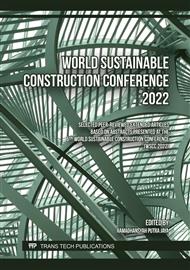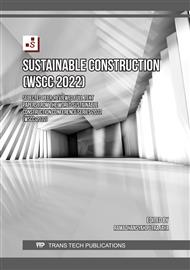[1]
J. Quashigah, P. N., Appeaning Addo, K., Amisigo, B., and G. Wiafe, "Assessment of short-term beach sediment change in the Volta Delta coast in Ghana using data from Unmanned Aerial Vehicles (Drone),", Ocean and Coastal Management, 182(September), 104952, 2019
DOI: 10.1016/j.ocecoaman.2019.104952
Google Scholar
[2]
L.c Mentaschi, M. I. Vousdoukas, J. F.c Pekel, E.c Voukouvalas, and L. Feyen, "Global long-term observations of coastal erosion and accretion," Scientific reports, 8(1), 1-11, (2018)
DOI: 10.1038/s41598-018-30904-w
Google Scholar
[3]
V. H. A. Ribeiro, G. Reynoso-Meza and L. dos Santos Coelho, " Multiobjective optimization design procedures for data-driven unmanned aerial vehicles automatic target recognition systems," In Unmanned Aerial Systems (pp.231-256). Academic Press, (2021)
DOI: 10.1016/b978-0-12-820276-0.00017-0
Google Scholar
[4]
H. Umar, S. Rahman, A. Y. Baeda, and S. Klara, "Identification of coastal problem and prediction of coastal erosion sedimentation in South Sulawesi," Procedia Eng., vol. 116, no. 1, p.125–133, 2015
DOI: 10.1016/j.proeng.2015.08.273
Google Scholar
[5]
F. A. Mohd et al., "Variation of beach profile along Pahang Coast in Malaysia," Int. J. Eng. Technol., vol. 7, no. 3.14 Special Issue 14, p.196–201, 2018.
DOI: 10.14419/ijet.v7i3.14.16884
Google Scholar
[6]
M. Mokhtar, F. Hayazi, A. Shahrin, A. Hamzah, M. Shahril, and S. Isnin, "Condition Survey of Eroded Area in Pantai Punggur, Malaysia Shoreline Using UAV Photogrammetry." Solid State Technology 63.3 (2020): 826-833., (2020)
Google Scholar
[7]
A. H. M. Rashidi, M. H. Jamal, M. Z. Hassan, S. S. M. Sendek, S. L. M. Sopie, and M. R. A. Hamid, "Coastal structures as beach erosion control and sea level rise adaptation in malaysia: A review," Water (Switzerland), vol. 13, no. 13, p.1–34, 2021.
DOI: 10.3390/w13131741
Google Scholar
[8]
M. Eliot, Coastal sediments , beaches and other Information Manual 8, no. November. 2016.
Google Scholar
[9]
M. Kaamin et al., "Mapping shoreline position using unmanned aerial vehicle," AIP Conf. Proc., vol. 2016, no. September, 2018.
DOI: 10.1063/1.5055465
Google Scholar
[10]
C.I. Yoo and T.S. Oh, "Beach volume change using UAV photogrammetry Songjung Beach, Korea," Int Arch Photogramm Remote Sens Spat Inf Sci XLI-B8:1201–1205, (2016)
DOI: 10.5194/isprsarchives-xli-b8-1201-2016
Google Scholar
[11]
A. Ulvi, "The effect of the distribution and numbers of ground control points on the precision of producing orthophoto maps with an unmanned aerial vehicle," Journal of Asian Architecture and Building Engineering, 20(6), 806-817, (2021)
DOI: 10.1080/13467581.2021.1973479
Google Scholar
[12]
M. I. Siddiq, M. E. Daud, M. Kaamin, M. Mokhtar, A. S. Omar, & N. A. Duong, "Investigation of Pantai Punggur Coastal Erosion by using UAV Photogrammetry.," International Journal of Nanoelectronics & Materials, 15, (2022)
Google Scholar
[13]
P. Aryastana, I. M. Ardantha, and K. W. Candrayana, "Coastline change analysis and erosion prediction using satellite images," MATEC Web Conf., vol. 197, p.1–5, 2018.
DOI: 10.1051/matecconf/201819713003
Google Scholar
[14]
BS 1377. "Methods of Test for Soils for Civil Engineering Purposes. Part 2: Classification Tests". British Standards Institution, London, England, 1990Z.
Google Scholar
[15]
M. Ali, L. W. Tan, S. Mohd Moharjir, S. Tahar, A. Fadillah, and A. Hakimd, "Sediment Properties of Pantai Punggur," no. March, p.114–119, 2015, [Online]. Available: http://www.worldresearchlibrary.org/up_proc/pdf/20-1428144164114-119.pdf.
Google Scholar
[16]
Al-Bared, MA Mohammed, and Aminaton Marto. "A review on the geotechnical and engineering characteristics of marine clay and the modern methods of improvements." Malaysian Journal of Fundamental and Applied Sciences 13.4 (2017): 825-831.
DOI: 10.11113/mjfas.v13n4.921
Google Scholar
[17]
W. Lick and J. McNeil, "Effects of sediment bulk properties on erosion rates," Science of7the Total Environment, 266(1-3), 41-48, (2001)
DOI: 10.1016/s0048-9697(00)00747-6
Google Scholar



